标签:dem ace throws 准备工作 The 如何 注意 地址 version
1. 什么是shiro
shiro是apache的一个开源框架,是一个权限管理的框架,实现 用户认证、用户授权。
spring中有spring security (原名Acegi),是一个权限框架,它和spring依赖过于紧密,没有shiro使用简单。
shiro不依赖于spring,shiro不仅可以实现 web应用的权限管理,还可以实现c/s系统,
分布式系统权限管理,shiro属于轻量框架,越来越多企业项目开始使用shiro。
2. 在应用程序角度来观察如何使用Shiro完成工作(图01)
Subject:主体,代表了当前“用户”,这个用户不一定是一个具体的人,与当前应用交互的任何东西都是Subject,如网络爬虫,机器人等;即一个抽象概念;所有Subject 都绑定到SecurityManager,与Subject的所有交互都会委托给SecurityManager;可以把Subject认为是一个门面;SecurityManager才是实际的执行者;
SecurityManager:安全管理器;即所有与安全有关的操作都会与SecurityManager 交互;且它管理着所有Subject;可以看出它是Shiro 的核心,它负责与后边介绍的其他组件进行交互,如果学习过SpringMVC,你可以把它看成DispatcherServlet前端控制器;
Realm:域,Shiro从从Realm获取安全数据(如用户、角色、权限),就是说SecurityManager要验证用户身份,那么它需要从Realm获取相应的用户进行比较以确定用户身份是否合法;也需要从Realm得到用户相应的角色/权限进行验证用户是否能进行操作;可以把Realm看成DataSource,即安全数据源。

3. shiro架构(图02)
3.1 subject:主体,可以是用户也可以是程序,主体要访问系统,系统需要对主体进行认证、授权。
3.2 securityManager:安全管理器,主体进行认证和授权都是通过securityManager进行。securityManager是一个集合,
真正做事的不是securityManager而是它里面的东西。
3.3 authenticator:认证器,主体进行认证最终通过authenticator进行的。
3.4 authorizer:授权器,主体进行授权最终通过authorizer进行的。
3.5 sessionManager:web应用中一般是用web容器(中间件tomcat)对session进行管理,shiro也提供一套session管理的方式。
shiro不仅仅可以用于web管理也可以用于cs管理,所以他不用web容器的session管理。
3.6 SessionDao: 通过SessionDao管理session数据,针对个性化的session数据存储需要使用sessionDao
(如果用tomcat管理session就不用SessionDao,如果要分布式的统一管理session就要用到SessionDao)。
3.7 cache Manager:缓存管理器,主要对session和授权数据进行缓存(权限管理框架主要就是对认证和授权进行管理,
session是在服务器缓存中的),比如将授权数据通过cacheManager进行缓存管理,
和ehcache整合对缓存数据进行管理(redis是缓存框架)。
3.8 realm:域,领域,相当于数据源,通过realm存取认证、授权相关数据(原来是通过数据库取的)。
注意:authenticator认证器和authorizer授权器调用realm中存储授权和认证的数据和逻辑。
3.9 cryptography:密码管理,比如md5加密,提供了一套加密/解密的组件,方便开发。比如提供常用的散列、加/解密等功能。比如 md5散列算法(md5只有加密没有解密)。

准备工作:
1、导入相关依赖
2、编写shiro.ini文件
[users] zs=123 ls=456 ww=789
pom.xml
<?xml version="1.0" encoding="UTF-8"?> <project xmlns="http://maven.apache.org/POM/4.0.0" xmlns:xsi="http://www.w3.org/2001/XMLSchema-instance" xsi:schemaLocation="http://maven.apache.org/POM/4.0.0 http://maven.apache.org/xsd/maven-4.0.0.xsd"> <modelVersion>4.0.0</modelVersion> <groupId>com.cjh</groupId> <artifactId>shiro</artifactId> <version>1.0-SNAPSHOT</version> <packaging>war</packaging> <name>shiro Maven Webapp</name> <!-- FIXME change it to the project‘s website --> <url>http://www.example.com</url> <properties> <project.build.sourceEncoding>UTF-8</project.build.sourceEncoding> <maven.compiler.source>1.7</maven.compiler.source> <maven.compiler.target>1.7</maven.compiler.target> <maven.compiler.plugin.version>3.7.0</maven.compiler.plugin.version> <!-- 添加相关依赖 --> <junit.version>4.12</junit.version> <servlet.version>4.0.0</servlet.version> <log4j2.version>2.9.1</log4j2.version> <slf4j.version>1.7.7</slf4j.version> <log4j2.disruptor.version>3.2.0</log4j2.disruptor.version> <shiro.version>1.2.5</shiro.version> </properties> <dependencies> <!-- shiro核心包 --> <dependency> <groupId>org.apache.shiro</groupId> <artifactId>shiro-core</artifactId> <version>${shiro.version}</version> </dependency> <!-- 添加shiro web支持 --> <dependency> <groupId>org.apache.shiro</groupId> <artifactId>shiro-web</artifactId> <version>${shiro.version}</version> </dependency> <!--**********junit**********--> <dependency> <groupId>junit</groupId> <artifactId>junit</artifactId> <version>${junit.version}</version> <scope>test</scope> </dependency> <!--**********servlet**********--> <dependency> <groupId>javax.servlet</groupId> <artifactId>javax.servlet-api</artifactId> <version>${servlet.version}</version> <scope>provided</scope> </dependency> <!-- ********************** 日志配置 ********************** --> <dependency> <groupId>org.slf4j</groupId> <artifactId>slf4j-api</artifactId> <version>${slf4j.version}</version> </dependency> <dependency> <groupId>org.slf4j</groupId> <artifactId>jcl-over-slf4j</artifactId> <version>${slf4j.version}</version> <scope>runtime</scope> <exclusions> <exclusion> <artifactId>slf4j-api</artifactId> <groupId>org.slf4j</groupId> </exclusion> </exclusions> </dependency> <!--2) 用于与slf4j保持桥接--> <dependency> <groupId>org.apache.logging.log4j</groupId> <artifactId>log4j-slf4j-impl</artifactId> <version>${log4j2.version}</version> <exclusions> <exclusion> <artifactId>slf4j-api</artifactId> <groupId>org.slf4j</groupId> </exclusion> </exclusions> </dependency> <!--3) 核心log4j2jar包--> <dependency> <groupId>org.apache.logging.log4j</groupId> <artifactId>log4j-api</artifactId> <version>${log4j2.version}</version> </dependency> <dependency> <groupId>org.apache.logging.log4j</groupId> <artifactId>log4j-core</artifactId> <version>${log4j2.version}</version> </dependency> <!--4) web工程需要包含log4j-web,非web工程不需要--> <dependency> <groupId>org.apache.logging.log4j</groupId> <artifactId>log4j-web</artifactId> <version>${log4j2.version}</version> <scope>runtime</scope> </dependency> <!--5) 需要使用log4j2的AsyncLogger需要包含disruptor--> <dependency> <groupId>com.lmax</groupId> <artifactId>disruptor</artifactId> <version>${log4j2.disruptor.version}</version> </dependency> </dependencies> <build> <finalName>shiro</finalName> <resources> <!--解决mybatis-generator-maven-plugin运行时没有将XxxMapper.xml文件放入target文件夹的问题--> <resource> <directory>src/main/java</directory> <includes> <include>**/*.xml</include> </includes> </resource> <!--解决mybatis-generator-maven-plugin运行时没有将jdbc.properites文件放入target文件夹的问题--> <resource> <directory>src/main/resources</directory> <includes> <include>*.properties</include> <include>*.xml</include> <include>*.ini</include> </includes> </resource> </resources> <pluginManagement><!-- lock down plugins versions to avoid using Maven defaults (may be moved to parent pom) --> <plugins> <!-- 编码和编译和JDK版本 --> <plugin> <groupId>org.apache.maven.plugins</groupId> <artifactId>maven-compiler-plugin</artifactId> <version>${maven.compiler.plugin.version}</version> <configuration> <source>${maven.compiler.source}</source> <target>${maven.compiler.target}</target> <encoding>${project.build.sourceEncoding}</encoding> </configuration> </plugin> <plugin> <artifactId>maven-clean-plugin</artifactId> <version>3.1.0</version> </plugin> <!-- see http://maven.apache.org/ref/current/maven-core/default-bindings.html#Plugin_bindings_for_war_packaging --> <plugin> <artifactId>maven-resources-plugin</artifactId> <version>3.0.2</version> </plugin> <plugin> <artifactId>maven-compiler-plugin</artifactId> <version>3.8.0</version> </plugin> <plugin> <artifactId>maven-surefire-plugin</artifactId> <version>2.22.1</version> </plugin> <plugin> <artifactId>maven-war-plugin</artifactId> <version>3.2.2</version> </plugin> <plugin> <artifactId>maven-install-plugin</artifactId> <version>2.5.2</version> </plugin> <plugin> <artifactId>maven-deploy-plugin</artifactId> <version>2.8.2</version> </plugin> </plugins> </pluginManagement> </build> </project>
Dome1.java
package com.cjh.shiro; import org.apache.shiro.SecurityUtils; import org.apache.shiro.authc.UsernamePasswordToken; import org.apache.shiro.config.IniSecurityManagerFactory; import org.apache.shiro.mgt.SecurityManager; import org.apache.shiro.subject.Subject; /** * @author * @site * @company * @create 2019-10-12 20:09 */ public class Demo1 { public static void main(String[] args) { /* 1.获取到安全管理器工厂securityManagerFactory 2.获取到安全管理器 3.将安全管理器交给securityuitl工具类 4、从securityutil中获取subject登录主体 5、获取jsp传递过来的用户名密然后形成一个token令牌 6、登录操作(登录成功?登录失败) */ IniSecurityManagerFactory factory = new IniSecurityManagerFactory("classpath:shiro.ini"); SecurityManager securityManager = factory.getInstance(); SecurityUtils.setSecurityManager(securityManager); Subject subject = SecurityUtils.getSubject(); // 模拟接收到了jsp从前端jsp传递过来的用户名密码去完成登录 String uname = "zs"; String pwd = "1234"; UsernamePasswordToken token = new UsernamePasswordToken(uname,pwd); try { subject.login(token); System.out.println("登录成功!!"); }catch (Exception e){ System.out.println("登录失败处理措施!!"); } subject.logout(); System.out.println("登出成功!!"); } }
1、准备一个shiro-web.ini文件
[main] #定义身份认证失败后的请求url映射,loginUrl是身份认证过滤器中的一个属性 authc.loginUrl=/login #定义角色认证失败后的请求url映射,unauthorizedUrl是角色认证过滤器中的一个属性 roles.unauthorizedUrl=/unauthorized.jsp #定义权限认证失败后请求url映射,unauthorizedUrl是角色认证过滤器中的一个属性 perms.unauthorizedUrl=/unauthorized.jsp [users] zs=123,role1 ls=123,role2 ww=123,role3 zdm=123,admin [roles] role1=user:create role2=user:create,user:update role3=user:create,user:update,user:delete,user:view,user:load admin=user:* #定义请求的地址需要做什么验证 [urls] #请求login的时候不需要权限,游客身份即可(anon) /login.do=anon #请求/user/updatePwd.jsp的时候,需要身份认证(authc) /user/updatePwd.jsp=authc #请求/admin的时候,需要角色认证,必须是拥有admin角色的用户才行 /admin/*.jsp=roles[admin] #请求/teacher的时候,需要权限认证,必须是拥有user:create权限的角色的用户才行 /user/teacher.jsp=perms["user:update"]
Web.xml
<?xml version="1.0" encoding="UTF-8"?> <web-app xmlns="http://xmlns.jcp.org/xml/ns/javaee" xmlns:xsi="http://www.w3.org/2001/XMLSchema-instance" xsi:schemaLocation="http://xmlns.jcp.org/xml/ns/javaee http://xmlns.jcp.org/xml/ns/javaee/web-app_3_1.xsd" version="3.1"> <display-name>Archetype Created Web Application</display-name> <context-param> <param-name>shiroConfigLocations</param-name> <param-value>classpath:shiro-web.ini</param-value> </context-param> <listener> <listener-class>org.apache.shiro.web.env.EnvironmentLoaderListener</listener-class> </listener> <filter> <filter-name>ShiroFilter</filter-name> <filter-class>org.apache.shiro.web.servlet.ShiroFilter</filter-class> </filter> <filter-mapping> <filter-name>ShiroFilter</filter-name> <url-pattern>/*</url-pattern> </filter-mapping> </web-app>
login.jsp
<%@ page contentType="text/html;charset=UTF-8" language="java" %> <html> <head> <title>Title</title> </head> <body> <h1>用户登陆</h1> <div style="color: red">${message}</div> <form action="${pageContext.request.contextPath}/login" method="post"> 帐号:<input type="text" name="username"><br> 密码:<input type="password" name="password"><br> <input type="submit" value="确定"> <input type="reset" value="重置"> </form> </body> </html>
main.jsp
<%@ page contentType="text/html;charset=UTF-8" language="java" %> <%@taglib prefix="r" uri="http://shiro.apache.org/tags" %> <html> <head> <title>Title</title> </head> <body> <h1>主界面<%=System.currentTimeMillis()%>,欢迎您:[${sessionScope.username}]</h1> <ul> 系统功能列表 <li> <a href="admin/addUser.jsp">用户新增</a> </li> <li> <a href="admin/listUser.jsp">用户查询</a> </li> <li> <a href="admin/resetPwd.jsp">重置用户密码</a> </li> <li> <a href="admin/updateUser.jsp">用户修改</a> </li> <li> <a href="user/updatePwd.jsp">个人密码修改</a> </li> <li> <a href="user/teacher.jsp">老师简介</a> </li> <li> <a href="${pageContext.request.contextPath}/logout">退出系统</a> </li> </ul> <ul> shiro标签 <li> <r:hasPermission name="user:create"> <a href="admin/addUser.jsp">用户新增</a> </r:hasPermission> </li> <li> <a href="admin/listUser.jsp">用户查询</a> </li> <li> <a href="admin/resetPwd.jsp">重置用户密码</a> </li> <li> <r:hasPermission name="user:update"> <a href="admin/updateUser.jsp">用户修改</a> </r:hasPermission> </li> <li> <a href="user/updatePwd.jsp">个人密码修改</a> </li> <li> <a href="${pageContext.request.contextPath}/logout">退出系统</a> </li> </ul> </body> </html>
LoginServlt
package com.cjh.shiro; import org.apache.shiro.SecurityUtils; import org.apache.shiro.authc.UsernamePasswordToken; import org.apache.shiro.subject.Subject; import javax.servlet.ServletException; import javax.servlet.annotation.WebServlet; import javax.servlet.http.HttpServlet; import javax.servlet.http.HttpServletRequest; import javax.servlet.http.HttpServletResponse; import java.io.IOException; /** * @author * @site * @company * @create 2019-10-12 20:30 */ @WebServlet("/login") public class LoginServlet extends HttpServlet { @Override protected void doGet(HttpServletRequest req, HttpServletResponse resp) throws ServletException, IOException { doPost(req,resp); } @Override protected void doPost(HttpServletRequest req, HttpServletResponse resp) throws ServletException, IOException { Subject subject = SecurityUtils.getSubject(); String uname = req.getParameter("username"); String pwd = req.getParameter("password"); UsernamePasswordToken token = new UsernamePasswordToken(uname, pwd); try { subject.login(token); req.getRequestDispatcher("main.jsp").forward(req,resp); }catch (Exception e){ req.setAttribute("message","用户名或密码错误!"); req.getRequestDispatcher("login.jsp").forward(req,resp); } } }
logoutservlt
package com.cjh.shiro; import org.apache.shiro.SecurityUtils; import org.apache.shiro.subject.Subject; import javax.servlet.ServletException; import javax.servlet.annotation.WebServlet; import javax.servlet.http.HttpServlet; import javax.servlet.http.HttpServletRequest; import javax.servlet.http.HttpServletResponse; import java.io.IOException; /** * @author * @site * @company * @create 2019-10-12 20:30 */ @WebServlet("/logout") public class LogoutServlet extends HttpServlet { @Override protected void doGet(HttpServletRequest req, HttpServletResponse resp) throws ServletException, IOException { doPost(req,resp); } @Override protected void doPost(HttpServletRequest req, HttpServletResponse resp) throws ServletException, IOException { Subject subject = SecurityUtils.getSubject(); subject.logout(); resp.sendRedirect("login.jsp"); } }
结果:


标签:dem ace throws 准备工作 The 如何 注意 地址 version
原文地址:https://www.cnblogs.com/chenjiahao9527/p/11666778.html